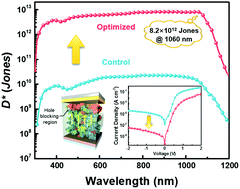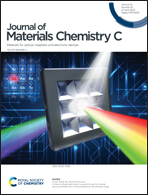Organic photodetectors with high detectivity for broadband detection covering UV-vis-NIR†
Abstract
Near-infrared (NIR) organic photodetectors (OPDs) are attractive candidates for future flexible electronic products and biomedical applications. However, current OPDs reported still suffer from low NIR sensitivity or a large dark current under bias. In this study, we showed that high performance OPDs with a high specific detectivity of over 1012 Jones in a wide broadband response range from 400 nm to 1100 nm can be achieved by suppressing the dark current density via mainly interfacial modification and morphology optimization in ternary devices derived from non-fullerene acceptors. For the optimized device, a peak specific detectivity of 8.2 × 1012 Jones (or 2.1 × 1013 Jones calculated from the shot noise) appears at 1060 nm with a high LDR over 100 dB, which is better than those of state-of-the-art OPDs in published papers and some commercialized Si-PDs at this wavelength. In-depth mechanism studies reveal that the hole blocking region of Y6 induced by solvent vapor annealing (SVA) and the reduced trap density using a thick film strategy in the PTB7-Th:COTIC-4F:Y6 ternary device can sufficiently work together to reduce the reverse charge injection and the leakage pathways, thus decreasing the noise current and boosting the detectivity of the OPDs. The results herein show the great potential of the BHJ-OPDs and will shed light on developing solution processible and flexible OPDs with performance comparable to that of commercial silicon photodetectors for efficient UV-vis-NIR light detection.



 Please wait while we load your content...
Please wait while we load your content...